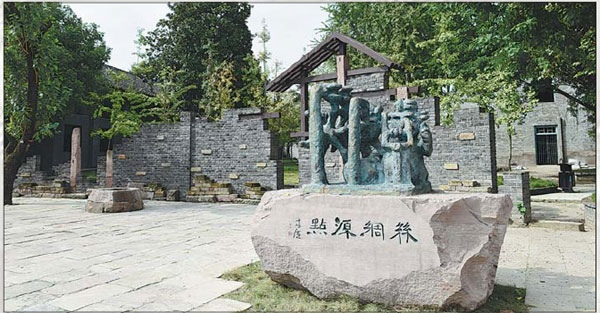Smooth Progress in Capitalizing on Silk History
Silk goddess, a sculpture revealed in 1987 in downtown Nanchong, Sichuan province, is a landmark and symbol of a city that has witnessed the rise and prosperity of China's silk industry.
It is believed that 5,000 years ago, the ancestors of Nanchong people began to plant mulberry, raise silkworms and weave silk fabric along the Jialing River.
In the Tang Dynasty (618-907), Huahong, a kind of fancy silk produced in Nanchong, was presented to the Japanese imperial family as a gift. It is now exhibited in Nara National Museum.
After the foundation of the People's Republic of China, the silk industry entered a period of rapid growth. In the early years, 80 percent of Nanchong people worked in silk-related industries.
The story of silk in Nanchong continues to modern times. The title "the source point of silk" was granted to the city by the China Silk Association in 2016. In the same year, the Nanchong city government put forward a development plan that named the silk and garment industry as one of the five pillar industries to drive economic development.
Now the local government is sparing no effort to support the silk and garment industry's upgrades and transformation.
A series of silk and garment industrial parks have been built to bolster the industry. More than 30 garment enterprises, including some companies from Shenzhen and Hong Kong, have settled down in the parks so far.
Since 2011, the silk and sericulture industry in Nanchong has spent 1.35 billion yuan ($192 million) on technological transformation and product development. Advanced machines and equipment have been introduced from Italy and France. By developing fine processing products, such as clothing and bedding, the industrial structure is becoming optimized.
Nanchong is also advancing the construction of scientific and research institutions. The planned institutions include a provincial silk school, a national technology research office for silk spinning and clothing, and five municipal technology centers.
Official statistics show that the total area of mulberry fields in Nanchong is 41,333 hectares. In 2017, Nanchong's economic aggregate in silk ranked No 1 in central and western China.
There were 72 silk and garment enterprises in the city, providing jobs for more than 30,000 people.
Nanchong has formed a complete industrial chain consisting of raw material supply, sericulture, silk reeling, weaving, product research and development, garment processing and export trade, local officials said.
Based on a robust industrial foundation and prominent industrial advantage, the goal to build Nanchong into a sericulture and silk tourism city was set in 2018.
With financial support from the local government, several silk and garment enterprises began to develop silk culture and industrial tourism.
Among such silk enterprises is Liuhe, which used to be the largest silk-reeling factory in Asia.
Founded in 1912, Liuhe is the oldest silk enterprise in China and known as the "living fossil" of the Chinese silk industry.
Guoshan Sericulture Agency, the predecessor of Liuhe, won the gold prize at the 1915 Panama-Pacific International Exposition for its raw silk.
In 2015, at the original site of the factory, Liuhe built a silk culture industrial park.
The park combines tourism, culture, sericulture and industry. Visitors can learn about the whole technological process of silk production in the last century such as cocoon cooking and silk reeling.
They can also have an interactive experience of operating silk-making equipment and purchase silk products.
"Industrial tourism can not only promote our sales, but also enhance Liuhe's brand influence. More importantly, it helps promote Nanchong's silk culture and carry it forward," said Li Yongchun, director of the culture industry department of Liuhe.
Through cooperation with travel agencies, more than 300,000 visits came to Liuhe in 2018. Liuhe's annual revenue from industrial tourism has reached 40 million yuan.
Another silk tourism spot in Nanchong is the silk museum built by leading textile company Yigeer.
With various exhibits and detailed explanation, the museum gives visitors a full picture ofNanchong's silk history and culture including the related tales and historical facts.
Yinhe Carpet, a silk enterprise working on hand-woven carpets for nearly half a century, is also building an exhibition center. "The center will be divided into several areas including display, performance and shopping, which can give visitors a brand-new experience," said Yang Shufen, deputy general manager of Yinhe Carpet.
To realize the goal, Nanchong will continue to combine its cultural promotion with industrial expansion. A number of planned scenic spots including an ecological mulberry field and the Dujing silk town will be built.
Scholars and researchers will dig into the silk culture and history in the central and western regions, study documents and cultural relics, and build a number of high-level museums and pavilions.
The local government also plans to hold festivals and make a TV series to improve the influence of Nanchong's silk culture.

Gaoping district in Nanchong is a cradle for China's silk industry.

